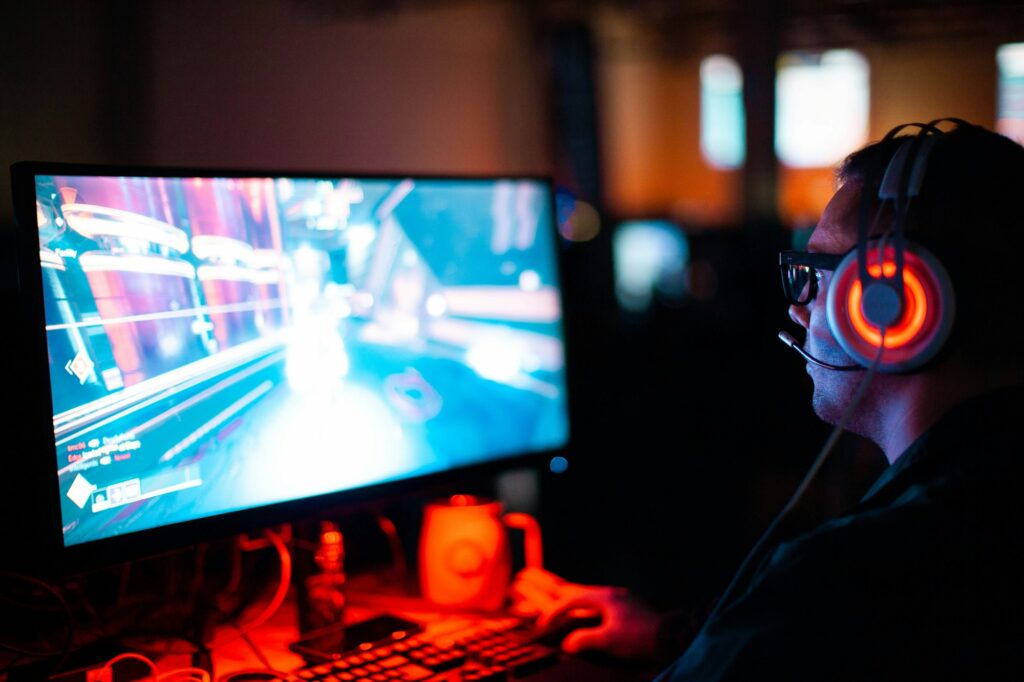In the rapidly evolving gaming industry, where player expectations for visual quality and immersive experiences continue to soar, traditional testing methods are increasingly proving inadequate. Game developers face unprecedented challenges in ensuring pixel-perfect graphics, seamless animations and consistent visual experiences across diverse platforms and devices. This is where visual testing emerges not just as a valuable tool, but as the defining methodology that will shape the future of game quality assurance.
Game QA has transformed dramatically from the early days of simple functional testing. Today’s games feature complex graphics, intricate user interfaces, dynamic lighting systems and real-time visual effects that traditional code-based testing simply cannot adequately validate. According to recent industry research, with AI-driven testing tools becoming even more advanced in 2025, automated playtesting and smart bug detection are revolutionising how QA teams approach visual validation in gaming environments.
Modern game development demands a paradigm shift towards visual-first testing approaches that can handle the complexity of contemporary gaming experiences. This evolution has positioned us, at T-Plan, at the forefront of game QA innovation, providing image-based visual testing solutions specifically designed to meet the unique challenges of game development across all platforms and environments.

Table of Contents
The evolution of game QA challenges
The gaming landscape has undergone a revolutionary transformation over the past decade, creating testing challenges that traditional QA methodologies struggle to address effectively. Modern games are no longer simple, static experiences – they’re complex, dynamic worlds featuring advanced graphics engines, real-time ray tracing, procedurally generated content and sophisticated user interfaces that adapt to player behaviour.
Cross-platform complexity represents one of the most significant challenges facing game QA teams today. A single game must deliver consistent visual experiences across multiple platforms – PC, PlayStation, Xbox, Nintendo Switch, mobile devices and emerging platforms like VR headsets. Each platform has unique rendering capabilities, screen resolutions, aspect ratios and performance constraints that can dramatically affect visual appearance. Traditional testing approaches that focus on functional verification cannot adequately ensure visual consistency across this diverse ecosystem.
Real-time graphics and dynamic content create another layer of complexity that conventional testing methods cannot handle effectively. Modern games feature dynamic lighting systems that change based on time of day, weather effects that modify environmental appearance and procedurally generated content that creates unique visual scenarios in real-time. These dynamic elements make it impossible to predict and manually verify every possible visual state a game might present to players.
User interface sophistication in modern games has evolved far beyond simple menu systems. Contemporary games feature adaptive UIs that respond to player actions, customisable interface elements, overlay systems for social features and complex HUD elements that must remain readable across various visual scenarios. The visual complexity of these interfaces demands testing approaches that can validate appearance and readability across diverse conditions.
Performance-visual quality balance creates unique testing challenges where teams must ensure visual fidelity whilst maintaining smooth performance across target hardware configurations. Visual bugs might only manifest under specific performance conditions, making them difficult to detect through traditional testing methods that focus on ideal scenarios.
Player expectation escalation driven by advancing technology means that visual inconsistencies, graphical glitches, or UI problems that might have been acceptable in previous generations now represent significant quality issues that can damage player satisfaction and review scores. The tolerance for visual imperfections has decreased dramatically as players become accustomed to high-quality visual experiences.
These evolving challenges have created a testing environment where visual validation is no longer optional – it’s essential for competitive game development. Traditional approaches that rely on manual inspection or code-based verification simply cannot scale to meet the demands of modern game development cycles whilst ensuring the visual quality that players expect.
Traditional testing limitations in game development
Conventional game testing approaches, whilst valuable for functional verification, reveal significant limitations when applied to the visual complexity of modern gaming experiences. These traditional methodologies, developed for simpler software applications, struggle to address the unique visual requirements that define contemporary game quality.
Manual visual inspection represents the most common traditional approach to game visual testing, but its limitations become apparent when considering the scale and complexity of modern games. Human testers can only evaluate a finite number of scenarios within realistic timeframes and their ability to detect subtle visual inconsistencies varies based on fatigue, experience and subjective interpretation. Manual testing cannot adequately cover the thousands of visual states possible in dynamic gaming environments.
Code-based testing approaches focus on verifying that game systems function correctly according to specifications, but they cannot validate what players actually see on screen. A rendering system might execute perfectly from a code perspective whilst producing visual artifacts, colour inconsistencies, or layout problems that directly impact player experience. These approaches miss the critical gap between technical functionality and visual presentation.
Platform-specific testing often results in inconsistent coverage across different target platforms. Teams might thoroughly test on primary development platforms whilst providing limited coverage for secondary platforms, leading to visual inconsistencies that players discover post-launch. The resource requirements for comprehensive manual testing across all platforms make this approach increasingly impractical.
Regression testing challenges become particularly acute in visual contexts. When development teams make changes to graphics engines, UI systems, or visual effects, traditional testing approaches struggle to verify that these changes haven’t introduced unintended visual consequences elsewhere in the game. Manual verification of visual regression requires extensive human resources and cannot guarantee comprehensive coverage.
Timing and resource constraints in development cycles often force teams to compromise on visual testing coverage. Manual visual verification is time-intensive and difficult to parallelize effectively, creating bottlenecks that can delay releases or force teams to ship with reduced visual validation. The pressure to meet release deadlines often results in inadequate visual testing coverage.
Documentation and reproducibility issues plague traditional visual testing approaches. When human testers identify visual problems, documenting these issues in ways that enable developers to reproduce and resolve them can be challenging. Screenshots might not capture the dynamic nature of visual problems and written descriptions of visual issues can be subjective and imprecise.
Scale and consistency problems emerge when multiple testers evaluate visual elements. Different individuals might have varying standards for acceptable visual quality, leading to inconsistent bug reporting and difficulty prioritising visual issues. This subjectivity makes it difficult to establish consistent quality standards across development teams.
These limitations of traditional testing approaches create gaps in visual validation that can result in shipped games containing visual bugs, inconsistencies, or quality issues that negatively impact player experience. The solution lies in embracing automated visual testing methodologies that can provide comprehensive, consistent and scalable visual validation.
The visual testing revolution in gaming
Visual testing represents a fundamental paradigm shift in game QA methodology, moving from subjective, manual evaluation to objective, automated validation of visual game elements. This revolution addresses the core limitations of traditional testing approaches whilst providing scalable solutions for the complex visual requirements of modern game development.
Image-based automation fundamentals form the foundation of visual testing in gaming contexts. Instead of relying on code-based verification or manual inspection, visual testing systems capture and analyse actual rendered game images, comparing them against established baselines to detect visual variations. This approach validates what players actually see, rather than what code logic suggests they should see.
Automated visual regression detection enables development teams to identify unintended visual changes quickly and consistently. When developers modify graphics systems, update art assets, or change UI elements, visual testing systems can automatically detect when these changes affect other parts of the game’s visual presentation. This capability is particularly valuable in complex games where modifications to one system might have unexpected visual consequences elsewhere.
Cross-platform visual consistency validation becomes achievable through automated visual testing approaches that can verify consistent visual presentation across different target platforms. Rather than requiring extensive manual verification on each platform, visual testing systems can automatically compare rendered outputs to ensure consistent player experiences regardless of hardware configuration.
Dynamic content testing capabilities enable visual validation of procedurally generated content, real-time effects and adaptive UI elements that traditional testing methods cannot adequately address. Visual testing systems can capture and validate the appearance of dynamic game elements across various states and conditions, ensuring visual quality even in unpredictable gaming scenarios.
Pixel-perfect accuracy provided by visual testing systems enables detection of subtle visual issues that human testers might miss, such as minor colour variations, slight misalignments, or rendering artifacts that could accumulate into noticeable quality problems. This precision ensures that games meet the high visual standards that contemporary players expect.
Comprehensive coverage potential emerges from visual testing’s ability to validate every visible element of a game systematically. Unlike manual testing that might focus on specific areas or scenarios, automated visual testing can provide complete coverage of game visuals, ensuring that no visual element goes unverified.
Objective quality standards replace subjective human interpretation with consistent, measurable visual quality criteria. Visual testing systems apply identical standards across all evaluations, eliminating the variability inherent in human visual assessment and enabling consistent quality decisions.
The visual testing revolution extends beyond simple automation – it enables entirely new approaches to game quality assurance that were previously impossible. Development teams can now implement continuous visual validation throughout development cycles, catching visual issues early when they’re easier and less expensive to resolve.
T-Plan Robot: revolutionising game QA through image-based testing
In the landscape of visual testing solutions, T-Plan Robot is considered as a comprehensive platform specifically designed to address the unique challenges of game QA. With over 25 years of experience in visual automation, we have evolved its technology to meet the demanding requirements of modern game development, providing capabilities that extend far beyond traditional testing tools.
Universal platform compatibility represents one of our Robot’s most significant advantages for game QA teams. The platform provides seamless automation across web and mobile platforms, supporting Mac, Windows and Linux environments with unified application, code and file compatibility. This universal approach enables game developers to test consistently across all target platforms without requiring separate testing tools or methodologies for each environment.
Advanced image recognition technology forms the core of this approach to game visual testing. The system uses sophisticated visual recognition algorithms that can identify and interact with game elements based on their visual appearance rather than requiring access to game code or underlying system APIs. This capability is particularly valuable for testing games where traditional automation tools cannot access internal structures or when testing pre-compiled builds.
No-code test creation democratises game testing by enabling team members without programming expertise to create sophisticated visual tests and with our no-code automation platforms feature, intuitive drag-and-drop interfaces and record-and-playback functionality that allow QA teams to capture complex gaming scenarios and convert them into repeatable automated tests. This accessibility dramatically reduces the barriers to implementing comprehensive visual testing.
Remote and virtualized environment support addresses the reality of modern game development where teams often work with games running in virtual machines, remote development environments, or cloud-based gaming platforms. This capability to automate GUI testing seamlessly across remote environments using RDP and VNC connections enables testing scenarios that traditional tools simply cannot handle.
Dynamic content and real-time testing capabilities enable T-Plan Robot to handle the complex, ever-changing visual scenarios that characterise modern games. The platform can capture and validate visual elements that change in real-time, test procedurally generated content and verify the appearance of dynamic UI elements that adapt to player actions or game states.
Comprehensive visual regression detection ensures that changes to game graphics, UI elements, or visual effects don’t introduce unintended consequences elsewhere in the game. T-Plan Robot can automatically compare current visual states against established baselines, flagging any variations for review while intelligently filtering out insignificant differences that don’t affect player experience.
Integration with development workflows enables seamless incorporation of visual testing into existing game development pipelines. The platform supports automated events that use data from spreadsheets, databases, PDFs and text files with live data integration via APIs and web requests, enabling comprehensive end-to-end testing that validates entire gaming workflows rather than isolated visual elements.
Proven enterprise success in game development contexts demonstrates our effectiveness in real-world scenarios. The platform has been successfully deployed by major gaming companies who report significant improvements in visual quality assurance efficiency and effectiveness. Client testimonials reveal transformative impacts on testing workflows and game quality outcomes.
T-Plan Robot’s comprehensive approach to visual testing addresses the full spectrum of game QA challenges, from basic visual validation to complex cross-platform consistency verification. The platform’s combination of advanced technology, user-friendly interfaces and proven enterprise capabilities positions it as the definitive solution for teams serious about implementing world-class visual testing in their game development processes.
Key benefits of visual testing for game studios
The implementation of comprehensive visual testing methodologies delivers transformative benefits that extend far beyond simple bug detection, fundamentally enhancing how game studios approach quality assurance and product development. These advantages address both immediate operational challenges and long-term strategic objectives that define successful game development organisations.
Dramatic reduction in visual bugs reaching players represents perhaps the most immediate and measurable benefit of implementing visual testing systems. Automated visual validation catches visual inconsistencies, graphical glitches and UI problems before they reach players, preventing the negative reviews and player frustration that can damage game reception and studio reputation. This proactive approach to visual quality ensures that games launch with the polish that modern players expect.
Significant acceleration of testing cycles emerges from visual testing’s ability to automate previously manual processes. Where manual visual inspection might require days or weeks to cover comprehensive scenarios, automated visual testing can execute the same validation in hours or minutes. This acceleration enables more frequent testing iterations and supports agile development methodologies that require rapid feedback cycles.
Enhanced cross-platform consistency becomes achievable through systematic visual validation across all target platforms. Visual testing systems can automatically verify that games deliver consistent visual experiences whether players access them on high-end gaming PCs, mobile devices, or console platforms. This consistency ensures that players receive equivalent experiences regardless of their chosen platform, supporting broader market reach and player satisfaction.
Improved regression testing efficiency addresses one of game development’s most persistent challenges. When development teams modify graphics engines, update art assets, or change gameplay systems, visual testing can automatically verify that these changes haven’t introduced unintended visual consequences elsewhere in the game. This comprehensive regression validation prevents the accumulation of visual technical debt that can compromise game quality over time.
Resource optimisation and cost reduction result from visual testing’s ability to automate tasks that would otherwise require significant human resources. Development teams can reallocate QA professionals from routine visual verification to more strategic testing activities such as exploratory testing, user experience evaluation and complex scenario validation. This resource optimisation improves overall testing effectiveness whilst reducing operational costs.
Objective quality standards and measurement replace subjective visual assessment with consistent, measurable criteria. Visual testing systems apply identical standards across all evaluations, enabling teams to establish clear quality benchmarks and track visual quality improvements over time. This objectivity supports data-driven decision-making and helps teams prioritise visual improvements based on measurable impact.
Earlier defect detection and resolution becomes possible when visual testing is integrated into continuous development workflows. Rather than discovering visual issues during final testing phases when they’re expensive to resolve, teams can identify and address visual problems throughout development when fixes are simpler and less disruptive to project timelines.
Documentation and reproducibility improvements emerge from visual testing’s ability to capture detailed visual evidence of testing scenarios and outcomes. When visual issues are detected, the system automatically generates comprehensive documentation including baseline comparisons, difference highlights and reproduction steps. This documentation enables developers to understand and resolve visual issues more efficiently.
Scalability for growing game complexity ensures that visual testing capabilities can expand alongside game development ambitions. As studios develop larger, more complex games with sophisticated visual systems, automated visual testing scales to meet these demands without requiring proportional increases in human resources or testing timeframes.
Implementing visual testing in game development workflows
Successfully integrating visual testing into game development requires strategic planning that considers both technical implementation details and organisational change management. The most effective implementations align visual testing capabilities with existing development workflows whilst establishing processes that maximise the technology’s potential for improving game quality.
Development pipeline integration forms the foundation of effective visual testing implementation. Visual testing systems should integrate seamlessly with existing build systems, version control workflows and continuous integration pipelines. This integration enables automated visual validation to occur alongside other quality assurance activities, providing real-time feedback to development teams without disrupting established development rhythms.
Baseline establishment and management represents a critical early phase in visual testing implementation. Development teams must carefully establish visual baselines that represent acceptable quality standards for different game elements. These baselines serve as reference points for all subsequent visual comparisons, making their accuracy and comprehensiveness essential for effective visual testing outcomes.
Test scenario definition and prioritisation requires careful consideration of which visual elements and gameplay scenarios require automated validation. Teams should prioritise testing scenarios based on player impact, development risk and historical problem areas. This prioritisation ensures that visual testing efforts focus on areas where they can deliver maximum value for game quality and player experience.
Team training and adoption strategies ensure that development team members can effectively utilise visual testing capabilities. This includes training QA professionals on visual testing tools and methodologies, educating developers on how visual testing results inform their work and establishing processes for reviewing and responding to visual testing feedback.
Quality gates and decision criteria define how visual testing results influence development decisions. Teams must establish clear criteria for when visual differences represent actionable issues versus acceptable variations and determine how visual testing results integrate with other quality metrics to inform release decisions.
Continuous improvement and optimisation processes enable teams to refine their visual testing implementation over time. This includes analysing visual testing results to identify patterns, optimising test scenarios based on effectiveness data and updating baselines as game visual standards evolve throughout development.
Cross-team collaboration facilitation ensures that visual testing benefits extend beyond QA teams to encompass developers, artists and other stakeholders. Establishing communication protocols and shared understanding of visual testing capabilities enables more effective collaboration around visual quality objectives.
The most successful visual testing implementations treat the technology as an enabler of improved development practices rather than simply an additional testing tool. When properly integrated, visual testing becomes an integral part of how teams approach game development, providing continuous visibility into visual quality and enabling proactive management of visual game elements.
Future trends: AI and automation in game visual testing
The convergence of artificial intelligence, machine learning and visual testing technologies is creating unprecedented opportunities for advancement in game QA methodologies. These emerging trends promise to further revolutionise how development teams approach visual validation, offering capabilities that extend far beyond current automated testing approaches.
AI-powered visual analysis represents the next frontier in game visual testing, with intelligent systems that can understand visual context and identify meaningful differences whilst filtering out irrelevant variations. Machine learning algorithms trained on game visual data can distinguish between significant visual issues that affect player experience and minor differences that have no practical impact. This intelligence reduces false positives and enables QA teams to focus on genuinely important visual quality issues.
Automated test generation using AI technologies can analyse game content and automatically generate comprehensive visual test scenarios. Rather than requiring manual test case creation, AI systems can examine game assets, understand visual relationships and generate test scenarios that provide comprehensive coverage of visual game elements. This automation dramatically reduces the effort required to establish comprehensive visual testing coverage.
Predictive visual quality analytics enable teams to anticipate visual issues before they occur. By analysing patterns in visual testing data, AI systems can identify areas of games that are likely to experience visual problems and recommend proactive testing focus. This predictive capability enables more efficient allocation of testing resources and proactive quality management.
Real-time visual monitoring during gameplay sessions can provide continuous validation of visual game elements as players interact with games. AI-powered systems can monitor live gameplay and automatically detect visual anomalies, performance issues, or unexpected visual behaviours that might not be caught during pre-release testing phases.
Adaptive testing optimisation uses machine learning to continuously improve visual testing effectiveness. AI systems can analyse the success rates of different test scenarios, identify the most effective visual validation approaches and automatically optimise testing strategies based on historical effectiveness data.
Cross-platform visual standardisation through AI-driven analysis can automatically identify and recommend adjustments needed to achieve consistent visual experiences across different platforms. Machine learning systems can analyse visual differences between platforms and suggest specific modifications needed to improve cross-platform visual consistency.
Our foundation in visual recognition provides natural compatibility with these emerging AI-enhanced testing capabilities. The platform’s image-based approach creates an ideal foundation for incorporating machine learning algorithms that can intelligently analyse visual game content and provide sophisticated visual validation capabilities.
Embracing the visual testing future
The gaming industry stands at a pivotal moment where visual quality has become a defining factor in player satisfaction and commercial success. Traditional testing approaches, whilst valuable for functional verification, simply cannot meet the visual validation demands of contemporary game development. Visual testing has emerged not as an optional enhancement, but as an essential methodology for studios committed to delivering exceptional gaming experiences.
The evidence supporting visual testing’s transformative impact on game QA is compelling. Development teams implementing comprehensive visual testing report significant reductions in visual bugs reaching players, dramatic improvements in testing efficiency and enhanced ability to maintain visual consistency across complex, multi-platform gaming environments. These benefits translate directly into improved player satisfaction, stronger review scores and reduced post-launch support burdens.
T-Plan Robot’s comprehensive automation platform exemplifies the potential of modern visual testing solutions to revolutionise game QA. By combining advanced image recognition technology with user-friendly, no-code interfaces and universal platform compatibility, we enable game development teams to implement world-class visual testing without requiring extensive technical expertise or disruptive workflow changes.
The future of game QA will be increasingly defined by teams’ ability to validate visual quality systematically, consistently and comprehensively. As games continue to evolve in complexity and player expectations continue to rise, the studios that embrace visual testing methodologies will maintain competitive advantages through superior visual quality and more efficient development processes.
For game development studios evaluating their QA strategies, the question is not whether to implement visual testing, but how quickly they can adopt these methodologies to improve their games’ visual quality. With more than 25 years’ experience in visual automation, combined with proven success across hundreds of enterprise customers, demonstrates that comprehensive visual testing is not only achievable but essential for studios serious about delivering exceptional gaming experiences.
The visual testing revolution in game QA has begun and the studios that embrace this transformation will define the future of game quality assurance. The tools, methodologies and expertise needed to implement world-class visual testing are available today. The only remaining question is how quickly development teams will seize this opportunity to elevate their games’ visual quality and their players’ experiences. If you want to find out how we can support you, contact us today.


